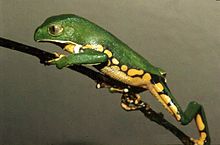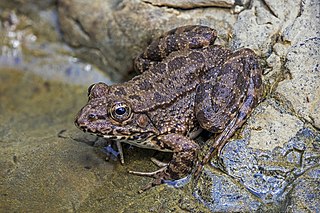
True frogs is the common name for the frog family Ranidae. They have the widest distribution of any frog family. They are abundant throughout most of the world, occurring on all continents except Antarctica. The true frogs are present in North America, northern South America, Europe, Africa, and Asia. The Asian range extends across the East Indies to New Guinea and a single species, the Australian wood frog, has spread into the far north of Australia.

Hylidae is a wide-ranging family of frogs commonly referred to as "tree frogs and their allies". However, the hylids include a diversity of frog species, many of which do not live in trees, but are terrestrial or semiaquatic.

Rhinodermatidae, also known as Darwin's frogs, mouth-breeding frogs or mouth-brooding frogs, is a small family of frogs found in temperate forests of southern Chile and adjacent Argentina.

The Rhacophoridae are a family of frogs that occur in tropical sub-Saharan Africa, South India and Sri Lanka, Japan, northeastern India to eastern China and Taiwan, south through the Philippines and Greater Sundas, and Sulawesi. They are commonly known as shrub frogs, or more ambiguously as "moss frogs" or "bush frogs". Some Rhacophoridae are called "tree frogs". Among the most spectacular members of this family are numerous "flying frogs".

Heleophrynidae is a family of frogs, commonly known as ghost frogs. They are thought to be the most basal group in the Neobatrachia. The family consists of two genera, Heleophryne and Hadromophryne, with seven species. Ghost frogs live in swift-moving mountain streams in South Africa. The common name of "ghost frogs" may have been coined because of their occurrence in Skeleton Gorge.

Cophylinae is a subfamily of microhylid frogs endemic to Madagascar. It has over 100 species in eight genera. Members of this subfamily range from minute to fairly large, and they are highly ecologically diverse. DNA barcode research has revealed a significant taxonomic gap in this subfamily, and an estimated 70+ candidate species were identified. Many of these have subsequently been described, as well as numerous new discoveries.
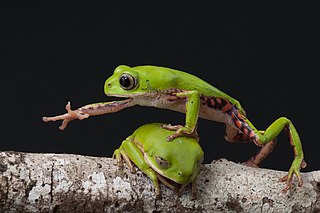
Pithecopus rohdei, also known as Rohde's leaf frog, Rohde's frog, and Mertens' leaf frog, is a species of frog in the subfamily Phyllomedusinae. The species was previously placed in the genus Phyllomedusa. The species is endemic to southeastern Brazil and occurs at elevations up to 1000 meters above sea level.

Hyloidea is a superfamily of frogs. Hyloidea accounts for 54% of all living anuran species. The superfamily Hyloidea branched off from its closest relative, the Australobatrachia, during the mid-Cretaceous. The fossil evidence found during the Cretaceous-Paleogene extinction event could not determine the effects upon the frogs, due to the lack of fossils. Increased forestation erupted after this extinction, possibly leading to more arboreal adaptations of these anurans to be best suited for this habitat.
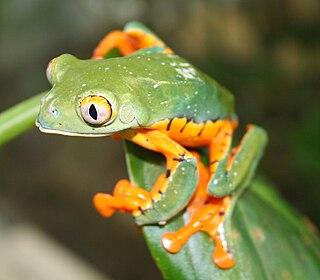
Cruziohyla calcarifer, the splendid leaf frog or splendid treefrog, is a species of tree frog of the subfamily Phyllomedusinae described in 1902 by George Albert Boulenger. It has a distribution from Esmeraldas Province in northwestern Ecuador, through western Colombia and Panama to the most southerly part of Costa Rica. It is a nocturnal, arboreal frog inhabiting primary humid lowland forest.
The Pinocchio frog or northern Pinocchio treefrog is a species of frog in the subfamily Pelodryadinae. It was discovered in the Foja Mountains of Papua Province in Indonesia by Conservation International and the National Geographic Society during a 2008 expedition, where it was accidentally spotted by Paul Oliver, a herpetologist. Despite being discovered in 2008, it remained undescribed and was long known simply as the "Pinocchio frog" until 2019, when it was finally described as Litoria pinocchio. The frog is named for its Pinocchio-like nose, which can enlarge and inflate in certain situations. Although unusual, a similar nose is found in several other related frogs from New Guinea, including L. chrisdahli, L. havina, L. mareku, L. mucro, L. pronimia and L. prora.

Pelodryadinae, also known as Australian treefrogs, is a subfamily of frogs found in the region of Australia and New Guinea, and have also been introduced to New Caledonia, Guam, New Zealand, and Vanuatu.
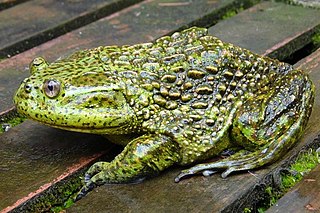
The Calyptocephalellidae are a family of toads found in Chile containing two living genera, Calyptocephalella and Telmatobufo.

Dendropsophini is a tribe of small neotropical tree frogs in the subfamily Hylinae. They are distributed from southern Mexico, throughout Central America, and down South America to northern Argentina and Uruguay. Removed from the synonymy of Hylinae in 2016, this taxon was formerly considered its own subfamily before being reclassified as a tribe. As defined by Favovich et al. in 2005, the tribe Dendrosophini contains the members of three former subfamilies within the Hylidae prior to taxonomic rearrangement: Dendropsophinae, Pseudinae, and Scinaxinae.
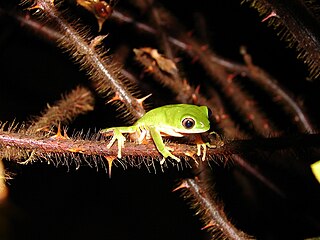
Pithecopus is a genus of frogs in the subfamily Phyllomedusinae. Species of the genus Pithecopus are found in tropical South America east of the Andes, from southern Venezuela to northern Argentina. Resurrected from the synonymy of Phyllomedusa in 2016, it corresponds to the former Phyllomedusa hypochondrialis group. Its sister group is Callimedusa.

Afrobatrachia is clade of frogs in the suborder Neobatrachia, all of which are restricted to Africa, including some species in Madagascar and the Seychelles. It is the sister group to the clade Natatanura, which contains all other members of Ranoidea aside from Microhylidae

Myobatrachoidea is a superfamily of frogs. It contains two families, both of which are found in Australia, New Guinea, and the Aru Islands. Some sources group these two families into a single family Myobatrachidae.

Australobatrachia is a clade of frogs in the suborder Neobatrachia. It comprises three families of frogs with a Gondwanan distribution, being known from Chile, Australia, and New Guinea. Together, they form the sister group to the superfamily Hyloidea.
Phasmahyla lisbella is a species of treefrog in the subfamily Phyllomedusinae, endemic to Brazil. Scientists know it only from the type locality: Fazenda Ventania in Área de Protecão Ambiental Ventania.

Sooglossoidea is a superfamily of frogs. It contains only two highly divergent families consisting of three genera with two species each, one family being found in southwestern India and the other in the Seychelles.
Phyllomedusa chaparroi is a species of treefrog in the subfamily Phyllomedusinae endemic to Peru. Scientists have only seen it in two places.
